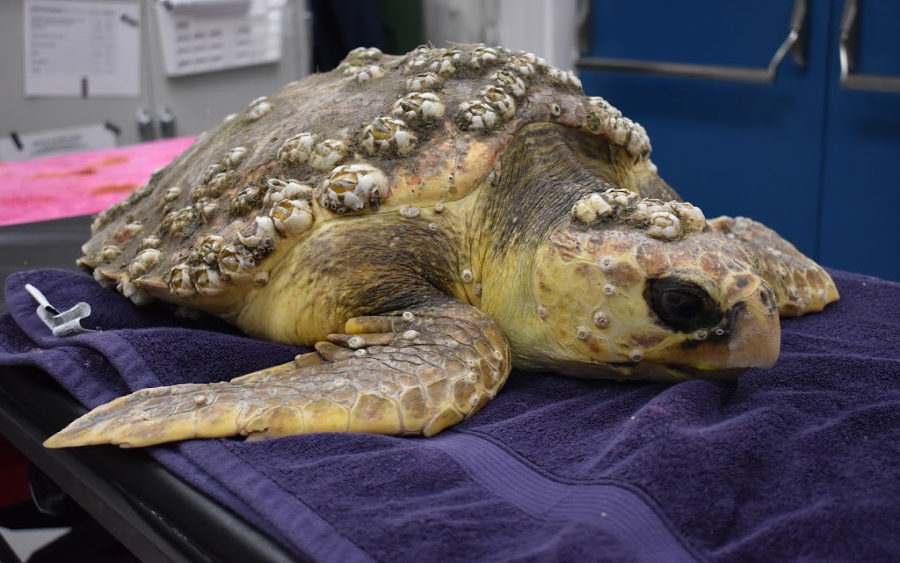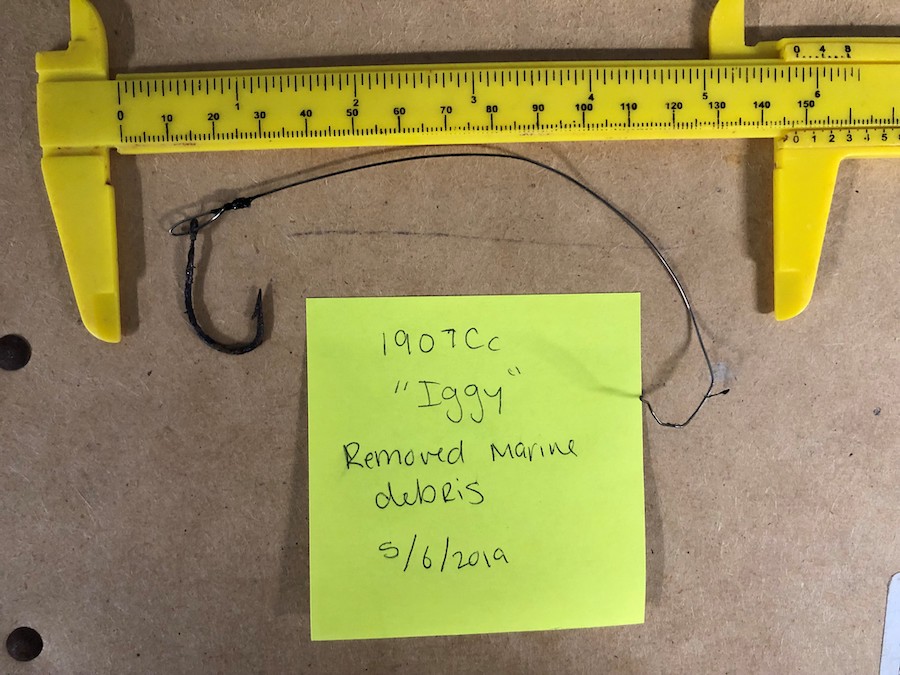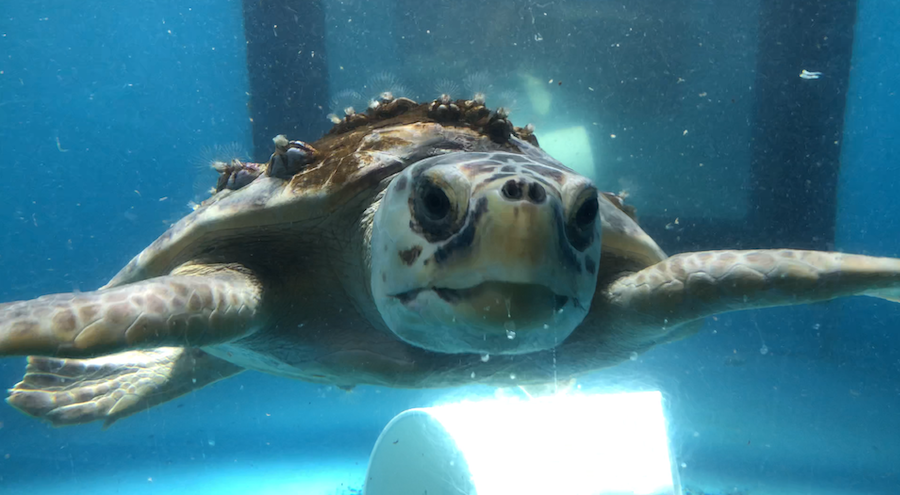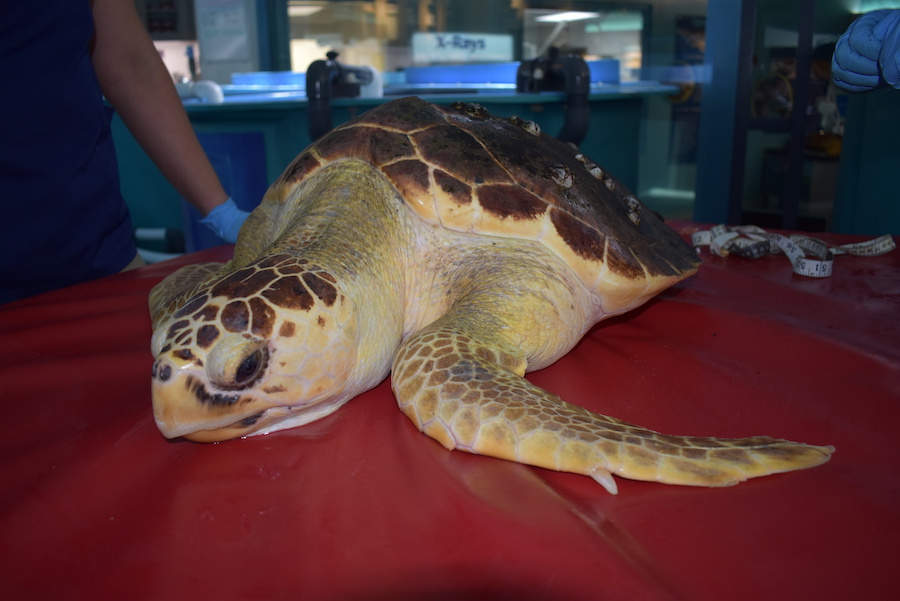Loggerhead Sea Turtle (Caretta caretta)
Stranding Location: Myrtle Beach State Park Pier, SC
Arrival Date: 4/30/2019
Age: Juvenile
Weight: 16.16 kg (36.2 pounds)
Case History
Myrtle Beach State Park rangers received a call about a hooked loggerhead sea turtle at the pier. Once at the scene, state park rangers carefully brought Iggy up by using a dip net and accessed the hooked turtle. Luckily for Iggy, the hook only caught the carapace (top shell). However, when the rangers saw that he was thin and was covered in more barnacles than usual, they called the South Carolina Department of Natural Resources (SCDNR). SCDNR transporter Linda Mataya of Surfside Garden City S.C.U.T.E promptly arrived at the pier to transport this little logger to the South Carolina Aquarium for treatment.
Iggy’s rehabilitation sponsored by Ingevity.
Treatment
When Iggy arrived, he was lethargic and was on the thinner side for a loggerhead. STCC staff quickly took a heart rate, pulled blood and set up the table for radiographs. To be sure there were no other hooks present in his esophagus or GI tract, vet staff did a series of radiographs. Unfortunately, radiographs showed that two J-hooks were located somewhere in the stomach and upper GI, along with a leader indicating that monofilament line could also be attached. Bloodwork results indicated that Iggy was also anemic, or had a low packed cell volume, and was dehydrated. Iggy was given fluids, vitamins, started on antibiotics, and received hetastarch to help draw fluids into the vascular space, aiding blood circulation and hydration. Vet staff decided that it would be best to let Iggy rest overnight after his big rescue and before undertaking surgery to remove the hooks.
Updates
May 1, 2019: Iggy received surgery the morning after admit to remove the hooks seen on x-ray. A small incision was made at the base of the esophagus and a flexible endoscope was used to visualize where the hooks were located within the stomach. Endoscope and CT showed that the hooks were actually below the stomach and through some of the intestinal loops and would not be able to be removed during that procedure. Given the location of the hooks, and Iggy’s anemia, we decided to give him a little time to see if he is able to pass them on his own before going in surgically again. We are closely monitoring the location of these hooks by taking radiographs to see how they are moving through the GI. Iggy’s prognosis is guarded, but we are hopeful that Iggy will be able to pass them without another another surgery.
May 2, 2019: Iggy was slow to recover from the effects of anesthesia but had a strong heartbeat and was breathing on his own following surgery. The next day, we placed Iggy in a shallow water tank and offered him one piece of food; Iggy ate immediately! For now, we are continuing the radiographs and monitoring him closely.
May 6, 2019: As luck would have it, Iggy passed the first hook and leader without surgery! He has been eating well and is less floaty than before. We will continue to monitor him closely for the second hook fragment to pass.
May 15, 2019: Since our last update, Iggy has been much more active and is now swimming at half a tank! He had a huge defecation and has passed the second hook fragment, rendering him hook free! We are slowly increasing his water level as he gets stronger and increasing his diet as well. We are super pumped that he is doing so well compared to how he looked when he came in, just a few weeks ago.
June 15, 2019: Iggy has been doing wonderfully since our last update! The sutures on Iggy’s incision site have been removed and the incision is all healed up. He is gaining weight and getting stronger every week. We also moved Iggy upstairs into first floor hospital, and he is diggin’ his new tank. Come visit Iggy!
July 1, 2019: Iggy has been doing great in his new tank! He is very active and splashy! We will pull him for a weight and physical exam in about two weeks. Iggy’s incision site has healed so well you can barely tell it’s there.
July 16, 2019: Iggy is doing well! He is often observed cruising around his tank and is very active. Last week we did a physical exam and checked on his weight — he’s around 45 pounds, but still has some weight to gain.
August 1, 2019: Iggy is an enthusiastic eater and is gradually, but consistently, gaining weight. His activity level and curiosity have made him a visitor favorite as guests pass through Zucker Family Sea Turtle Recovery!
August 15, 2019: Iggy continues to be a guest favorite and is one curious logger! His weight check this week showed us that he’s both growing and gaining weight, and his body condition looks better each time we see him out.
September 1, 2019: Iggy is doing well. He continues to be a very curious and active turtle. We get many questions about his barnacles. The truth is, they are harmless! The ones typically found in our waters aren’t parasitic. We usually leave the barnacles alone unless they are interfering with radiographs. Come check out Iggy and all his barnies!
October 1, 2019: Iggy had a big day this week as he was pulled to be evaluated for potential release. He received a physical exam, had blood drawn, and was weighed. Even though he only weighs around 45 pounds, he is one feisty fella — he gave our vet staff a run for their money during his exam. Iggy is donning some flipper tags and received a P.I.T tag; however, he might not be ready for release based on preliminary bloodwork results.
October 15, 2019: For the next couple of months, Iggy will be staying with us after his bloodwork didn’t meet our standards for release. We moved him into a larger tank in Zucker Family Sea Turtle Recovery, and he’s loving his larger temporary home!
November 1, 2019: Iggy is still doing wonderfully and has become quite the curious turtle! Iggy, like all of 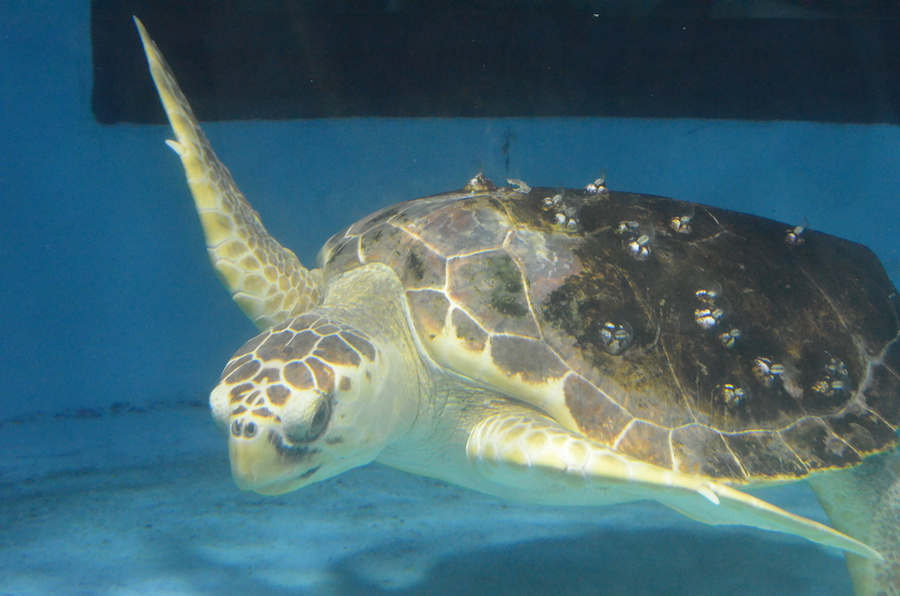 our patients, is a wild animal so we don’t want him to associate us with food. To help with this, we covered his tank window to prevent familiarization with us when we clean his tank. We also do broadcast feeding. This is when we put food in his tank when is looking in the opposite direction, and then we walk away. Iggy is starting to fill out and look great — he’s gained almost 9 pounds! Go, Iggy!
our patients, is a wild animal so we don’t want him to associate us with food. To help with this, we covered his tank window to prevent familiarization with us when we clean his tank. We also do broadcast feeding. This is when we put food in his tank when is looking in the opposite direction, and then we walk away. Iggy is starting to fill out and look great — he’s gained almost 9 pounds! Go, Iggy!
November 15, 2019: Iggy is doing great. He’s continuing to eat well and keep staff and volunteers busy by defecating three-to-four times a day! In the wild, it’s common for sea turtles to find rocks or other objects to scratch their shells on because they have the same sensation as the back of your fingernail. Iggy has been loving his backscratcher. It also helps him shed layers of his shell which helps him grow!
December 1, 2019: Iggy is doing great! We will conduct another exam and blood pull to see where his blood values stand so we can reevaluate his release in January. Don’t worry, Iggy will be with us for a little bit longer, so you’ll have plenty of time to come say goodbye before his release!
January 1, 2020: Iggy continues to gain weight and spends most of his days cruising around his tank and hanging out under his backscratcher.
January 15, 2020: Earlier this week, Iggy was pulled for a bloodwork recheck, weight, measurement and overall physical exam by our vet staff. When we were originally evaluating him for release, his bloodwork wasn’t quite within normal limits. Keep your fingers crossed his bloodwork comes back within normal limits, so that he’s one step closer to getting released!
February 1, 2020: Iggy’s bloodwork came back and it was pretty normal. Our veterinarian is still in the process of evaluating him for release, so stay tuned!
February 15, 2020: Iggy was released on the sandy beaches of Cape Canaveral National Seashore in Florida. Due to chilly local water temperatures during this time of year, we cannot release our patients off our local beaches.
*Iggy’s rehabilitation sponsored by Ingevity*


